|
Early Trades , Blisworth, Northamptonshire, UK. All pictures are presented at relatively low resolution. There will be hundreds of pictures on this site - there is an economic limit to the webspace available. The point of this presentation is that you can see for yourself the extent of the collection and return later as the collection expands - as it surely will. Any interest in copies of a picture at a higher resolution (ie. clarity) should be directed through contacts given in the Blisworth "Round and About" parish council publication or using the comment form on the home page. In some cases the pictures are not available due to copyright restrictions. However, permission has been obtained, where possible, to include them here. Printed below each image is the photographer's name, if known. |
||
|
This section deals with any trades on which there is not much material. Ironstone mining, Farming and Canal works, to mention a few, have their own pages. |
||
|
||
 |
There is very little recorded on house building. However a notable point about Blisworth is the polychrome stone banding using in building the majority of 18th century houses. A rather tidy form of the design continued in more recent construction. 11-01 The main reason for the design shown in this image is that both the locally available stones have disadvantages as a material - the limestone is rather too soft and therefore too weak and the ironstone, especially any blocks with high iron ore content, cannot be sawn. Blisworth is not the only Northamptonshire village to display polychrome banding.
|
|
|
11-02 The disused limestone quarry in c. 1950. It has now been land-filled - it was located half a mile behind the "Blisworth Stone Works" on the Stoke Road (see image 30-20). The quarry was probably in operation as early as 1800. Its production was certainly significant between 1821 and 1914. It was closed in 1921 when the Hunsbury iron furnaces near Northampton closed down because of operational difficulties after WWI. Most of the stone was sent down a wagon track to a canal wharf at the Ironstone Bridge (see image 17-02). From there it was shipped by canal to Blisworth Arm and thence to the iron furnaces wharf and thence to Hunsbury where it was used as a flux. One difficulty the iron company experienced was a severe shortage of towing horses for the narrow boats after the war.
|
||
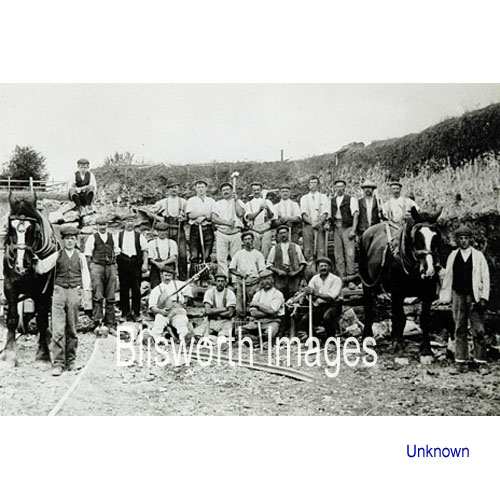 |
11-02a A group of limestone
quarriers, c. 1900.
Left - right: top, 'small boy?', J Griffin (bowler), ?, 'Fatty' Goodridge, W Jackson, Wm Pinfold, Brothers Gardener, A Gibbs, ? Middle: Archibold Goodridge, ?, Jim Battams, Harry Leach, Geo. Trusler, Will Wooton, ?. Seated: Alfred Harris, ?, Bowbridge, Wm York. |
|
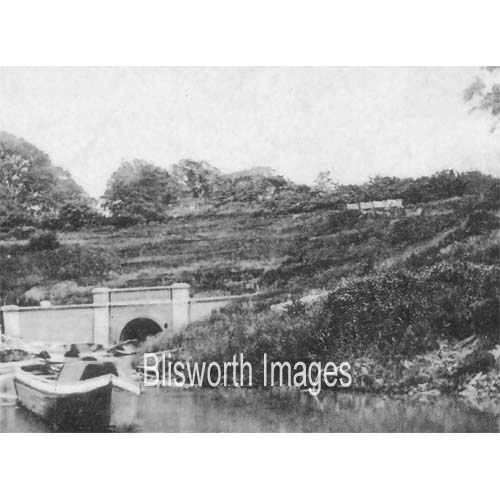 |
11-02b There are better views of this scene but here we can see a group of limestone wagons at rest on the railway running down from the quarry to the wharf on the canal (see images 08-03 and 04). The date is thought to be 1903/4, just as the new portal brickwork was completed. This picture is from a postcard on which is shown also a newly built hut (just off to the left).
|
|
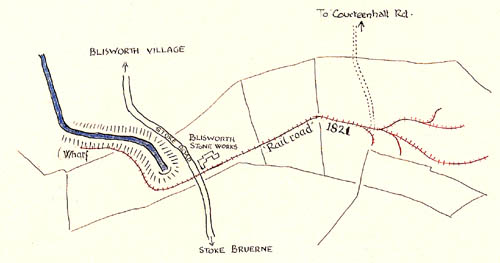 |
A map included in the scrapbook shows where the railway crossed the Stoke Road. A short article is posted on this website regarding the operation of this railway and an overview of all Blisworth mining is given here. | |
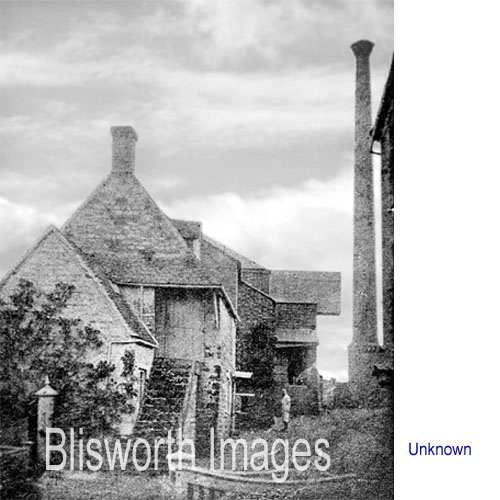 |
11-03 This is a very old picture of Westley's bakehouse and corn mill on the Stoke Road. The tall house to the extreme right is Westley's house which was used by the bacon factory after 1924. Westleys closed down the baking side to their business when Joseph Westley jnr. died in 1895. It was then transferred to Thomas Sturgess (see Personalities section for both Westley and Sturgess). The son William Sturgess continued and, by 1924 when the land was sold to the British Bacon Company, he had set up a bake house on land next to Jasmine Cottage on the High Street.
|
|
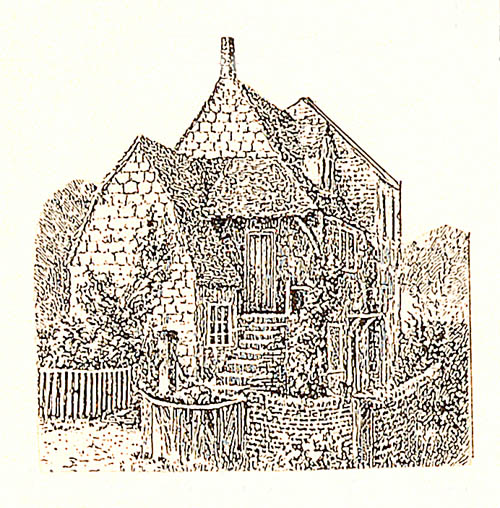 |
The origin of this sketch is not known. It
was pasted into one of the pages of the scrapbook and suggests a garden
layout prior to the building of the house at the right of the plot - ie.
before 1798 when the great fire destroyed
the school next door (but not this building).
Associated collection of images here. |
|
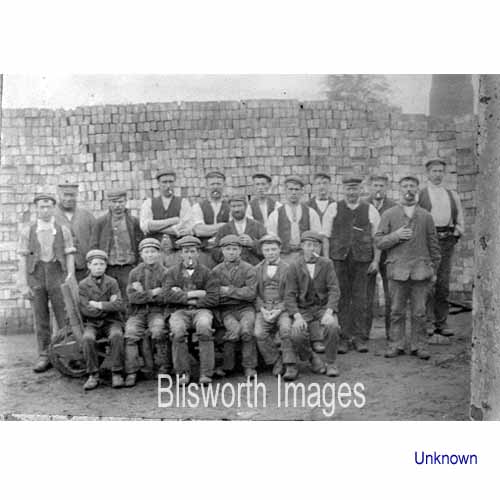 |
11-03a Beneath the sand
and limestone layers there is a deep layer of "lias" blue clay
and the arrival of both canal and railway called for thousands of bricks
to be made locally. This and the next photograph are believed to
have been taken at Asplin's brickyard which was located near to
Blisworth Arm (actually in Gayton Parish). The yard remained in
operation until the 1930's and was a significant source of employment
for villagers.
"Impromptu" brickworks were set up on Blisworth Hill to convert some of the clay from the tunnel digging into bricks for the tunnel lining. These have been removed but occasionally a floor of bricks and burnt brick rubbish has been found by farmers. George Freeston has pointed out that many men/boys seem to have make-believe fags in their mouths. |
|
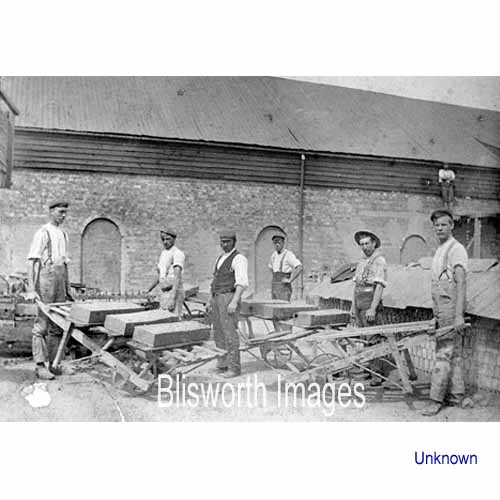 |
11-03b The two men to the extreme left and right are Mallard brothers. | |
|
11-04 The Burbidge family had been established in the village since the mid-1880's when Charles arrived from Gayton with six children. One of them, Fred, set up a timber business based on the family's experience with steam traction engines. Fred cut and tidied many of the Grafton estate woods and his workers are pictured here in the grounds of Stow with a load of timber.
|
||
| 11-05 Pictured in the Stoke Park, Fred Burbidge sizing up the stands. | ||
|
11-06 In the yard off the High Street was plenty of room for Burbidge's carpentry business in which almost anything that a farmer might need was turned out efficiently in wood. In addition, there was a line in elm coffin boards pictured stacked here. No doubt the Freeston undertakers business would be steady customers for the boards.
|
||
|
Footnote: Burbidge was a quite active exporter of coffins boards. |
||
| 11-07 A group of Burbidge's workers in front of a steam-driven saw. | ||
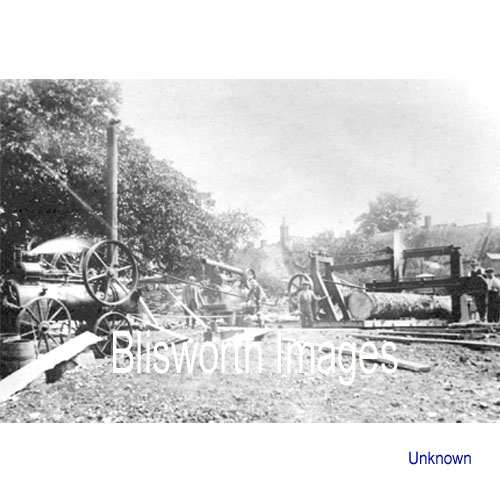 |
11-10 This picture is also shown in the High Street section. The engine on the left is driving a circular saw which has its axle below ground level. The machinery on the right appears to be a vertical reciprocating saw for dividing logs into planks. | |
| 11-09 The row of barns are located off the Gayton Road just a little further up from "The Bays" where the Burbidge family originally lived. This was probably where engineering work on steam engines was done. In the centre is shown an elevator built by E & H Roberts of Deanshanger at the Ironworks Factory. | ||
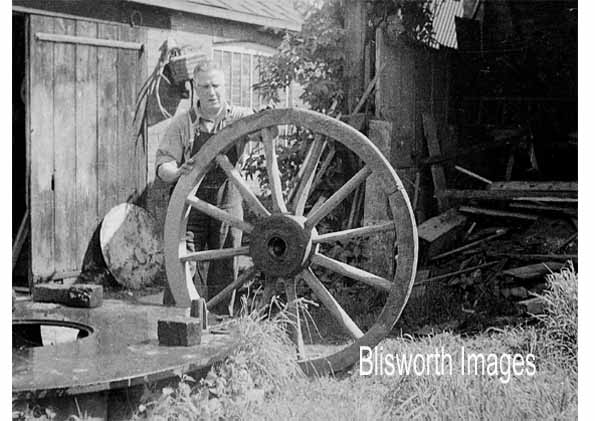
WHEELWRIGHTS The trade of the wheelwright is a traditional village one. As early as 1839 the Chester family were wheelwrights in the village, eventually at the crossroads by 1870. They ceased wheelwrighting in around 1880 but left their premises complete with various tools for the trade and Edwin Freeston, with his wife and four sons, moved in to continue in 1910. A year later, the Freeston's fifth son George was born. By clicking on the picture to the left you can see a sequence of pictures which describes the process. |
||
| 11-11 By dress "code" these men could be navvies. Although they perhaps called themselves navvies they were road repair men circa 1920 rather than "navigators" who worked on the canal structure. | ||
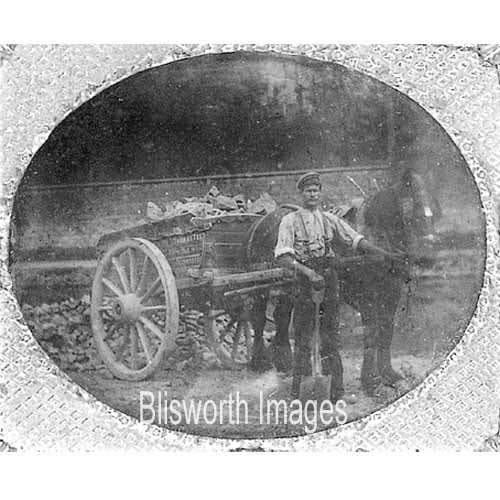
|
11-12 From 1877 - 1895, Thomas Tee was publican at the Royal Oak. Given the means to keep a horse and afford a cart, he also worked as part-time haulier. He was born 1839 and appears in the 1851 census as a man servant at the new Rectory. "Both Tom Tee and Chester did a bit of building. Tom Tee had a horse and cart and a bit of a farm - he used to do a bit of carting of stone from the canal and the Sun, Moon and Stars for breaking for the roads" - Witty Whitlock, c.1970.
|
|